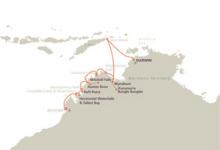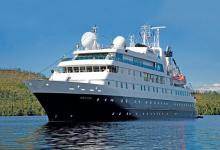Recently Viewed Cruises
- Orion, Kimberley Expedition ex Darwin to BroomeAdd to favourites
- Orion, West Papua & Maluku ex Rabaul to DarwinAdd to favourites
- Orion, Papua New Guinea Cultural Highlights ex Cairns to RabaulAdd to favourites
- Yangzi Explorer, Downstream ex Chongqing to YichangAdd to favourites
- Yangzi Explorer, Upstream ex Yichang to ChongqingAdd to favourites
- Catch up on Cruising: Latest cruise news in bite size
- Oceania puts the flags out for Insignia
- Luxury cruising booms
- Catch up on Cruising: Latest cruise news in bite size
- Royal Caribbean International raises the bar
- Frequently Asked Questions
-
Orion, Kimberley Expedition ex Darwin to Broome
Nights 10 Ship Orion Star Rating 
Departs Darwin, Northern Territory, Australia Sailing 2013: 18 Apr ,8 May ,28 May ,17 Jun ,7 Jul ,27 Jul ,16 Aug ,5 Sep Ports of Call Darwin, Wyndham, King George River, Vansittart Bay, Hunter River, Montgomery Reef, Talbot Bay, Koolan Island, Broome Select a sailing date for approximate pricing.
Prices are per person, twin share. When booking please check current cruise fare and inclusions. Prices are indicative only, subject to currency fluctuations and may change at any time without notice.
10 Night Kimberley Expedition Cruise departing from Darwin to Broome aboard Orion.
Orion's Expedition Team will lead your exploration of secluded beaches and river inlets - waters famous for an abundance of wildlife. From spectacular waterfalls and awe inspiring gorges, to ancient cultural history and indigenous rock art, the only way you can access the best of the Kimberley is from the sea onboard Orion.
Highights of this cruise include:
Darwin, Northern Territory
Darwin is Australia's closest city to the equator and the gateway to the Top End. Following bombing during World War II, Darwin was more a frontier town of crocodile and buffalo shooters and pioneer cattlemen. After the city was wiped out by Cyclone Tracy in 1974 it was rebuilt as Australia's cosmopolitan northernmost tropical capital. Beyond the city lies Litchfield National Park (about 2 hours drive) and to the south-east the teeming wetlands of Australia's largest national park, Kakadu. Much architecture remains from the city's early periods, with museums, markets and an incredible diversity of restaurants to keep visitors entertained. The harbour foreshore area is a great place to discover the city's maritime links. Take a relaxing cruise on an old pearl lugger, a thrilling flight in a seaplane or a gentle hovercraft trip. Spend a day out fishing for barramundi, jewfish, golden snapper and threadfin salmon, or go for the adventure of scuba diving around shipwrecks. At sunset, savour a taste of Asia's night markets at Mindil Beach, where you can browse the food stalls for a picnic dinner on the beach.
Wyndham (for Bungle Bungles)
Wyndham is the northernmost town in Western Australia and is the gateway to the East Kimberley. For Orion guests, Wyndham is the starting point for a host of adventure opportunities and is surrounded by some of the most spectacular landforms, rivers and wetlands in the Kimberley.
The frontier township of Kununurra the green capital of the north, is about an hour's drive inland and owes its verdant surrounds to the largest manmade lake on the Australian mainland; the nearby Lake Argyle and the smaller Lake Kununurra.
Part of the history of the region is documented by Dame Mary Durack in her books Kings in Grass Castles and Sons in the Saddle. The former Durack Station is now flooded by Lake Argyle, however the homestead has been reconstructed and is now a museum.The region is also famous for the Argyle Diamond mine, the worlds' primary source of rare pink diamonds, which have become the company's signature stone. Argyle Diamonds is the worlds' largest supplier of diamonds producing over 30 million carats which accounts for around 25% of the world' natural diamond production.
Flight seeing over the World Heritage listed Bungle Bungle Range in Purnululu National Park affords a breathtaking perspective of these unique formations. Incredibly these ranges were not "discovered" until the mid 1980's when a television crew happened upon the starkly beautiful range and its unique, beehive-shaped domes. The domes are bordered by great banded cliffs that glow fire-red in the late afternoon sun.
King George River and Falls
Today Orion will drop anchor in Koolama Bay. Originally known as King George Bay, the area was renamed after the merchant ship Koolama was bombed near here by Japanese aircraft during World War II. The 12km journey up the King George River reveals some of the world's most spectacular scenery and a wealth of bird species. The almost vertical sheer canyon walls have been eroded over millions of years and look like stacks of sandstone reminiscent of a child's building blocks. The King George River drains the Gardner Plateau and the falls are the highest single-drop falls in the whole of the Kimberley (100m or 330ft). Whether you experience the mighty thundering of the falls early in the season, or have the chance to get up close and personal later in the year, you'll be in awe of the sight.
Vansittart Bay
Vansittart Bay is our destination, located at the southern end of Vansittart Bay. The island was so named by the explorer Phillip Parker King for the shards of pottery he found there, most likely left behind by Macassan traders. Other remnants of visits by the Macassans are tamarind trees which are not native to the Kimberley. After landing ashore, our destination will be an outdoor art gallery of Gwion Gwion (otherwise known as Bradshaw) Aboriginal art. Named after Joseph Bradshaw, the first European person to record them in 1891, the rock images are hard to date. It is believed they were created at least 17,000 yrs ago with some theories indicating they could be even older, potentially up to over 50,000 years ago when humans first explored this continent. If this is the case, the images are possibly the oldest known to man.
Hunter River (for Mitchell Falls)
Arguably one of the most scenic parts of the Kimberley coast, Prince Frederick Harbour and the Hunter River are lined with green rainforest, mangroves and soaring red cliffs. Cliffs at the river mouth are some 200 metres high and to the north Mt. Anderson rises to an impressive 480 metres. Today Orion will drop anchor close to Naturalist Island, the proper name of which is "Wunumpurramarra", on the northern side of the harbour. For those taking the flightseeing excursion, Orion's Zodiacs will land you on the main beach, some 300 metres long. An enormous number of shells can be found on the beach, many of which are home to hermit crabs who have taken possession of marine snail shells. This region has many crocodiles and you may be lucky enough to see them! For those wishing to explore some of the Kimberley's vast interior, today presents a wonderful opportunity. The distance from Naturalist's Island to the famous Mitchell Falls & Plateau is about 50km and you'll fly over some spectacular terrain. From the air you'll notice the natural bush landscape is littered with an unexpected feature - the palm! Livistona eastonii predominate and grow in the open eucalypt forest.
Montgomery Reef
Arriving at high tide, you'll see very little of Montgomery Reef. However as the tide drops rapidly away a raging torrent of water, cascading off the top of this 400ha reef, erupts as miles of surrounding reef appears to slowly rise out of the ocean. A Zodiac will maneuver you into a channel in the reef as water cascades down on either side. It's the perfect spot to watch cormorants, egrets and sandpipers forage for sea life trapped on the surface of the reef. Below the waterline opportunistic sea turtles, reef sharks and many larger fish also take advantage of this feast.
Raft Point
After landing ashore by Zodiac at Raft Point, your expedition leader will guide you on a climb up to a saddle of rock that forms nothing short of a spectacular outdoor Aboriginal art gallery. The art is an account of the mythical Wandjina clan on the 'Great Fish Chase'. There are images of the Wandjina spirits with their distinctive haloes and dugong, crocodiles, fish and snakes.
Talbot Bay/Horizontal Waterfalls
The Horizontal Waterfalls in the Buccaneer Archipelago are a product of the huge tides in the region, and the effect is created by the rapid tidal fall on the ocean-side of gaps in the cliffs. When conditions are right it is possible for a "waterfall" up to 3 metres high to form as the waters trapped on the landward side cascade out through the narrow gap to the ocean side. A flotilla of Orion's Zodiacs will take you for an exhilarating trip to witness the phenomenon of the falls. Later in the day join expedition team members on a Zodiac excursion to Cyclone Bay where the tortured geological folds of what was once seabed will be explained.
Nares Point & Crocodile Creek
Located just off Koolan Island, and known for the BHP iron ore mine which operated for several decades on the island, this geological finger of sandstone protruding into the ocean provides great opportunities for Zodiac cruising and guided walks along the beach.
The layered sandstone show its buckling and folding, evidence of millions of years of geological forces. Nearby Crocodile Creek defies its name, and due to several vertical embankments remains "crocodile free" allowing us to take advantage of the cool freshwater to relax and beat the Kimberley heat.
Broome, Western Australia
The charismatic town of Broome has a colourful history and a unique, cosmopolitan feel, which stems from its early pearling days when over 400 luggers plied the coast. The town is full of contrasts: stroll along kilometres of pristine white sand and swim in the clear water of Cable Beach or skim across tidal flats aboard a hovercraft to Gantheaume Point, home of the 130 million year old Dinosaur Footprints. Visit the Paspaley Pearls Boutique to sip champagne at an exclusive private viewing or take a walk along the white beaches and impossibly blue ocean. Spend some time uncovering the town's history at the Broome Historical Society Museum or reflect on the dangers of the early days of diving at the Japanese Shinto Cemetery, final resting-place for over 900 pearl divers. The fishing is great in Broome so board a fishing boat or simply try your hand at landing a big one from the deep water jetty. And if you enjoy bushwalking, the Minyirr Park has a number of self-guided trails.







